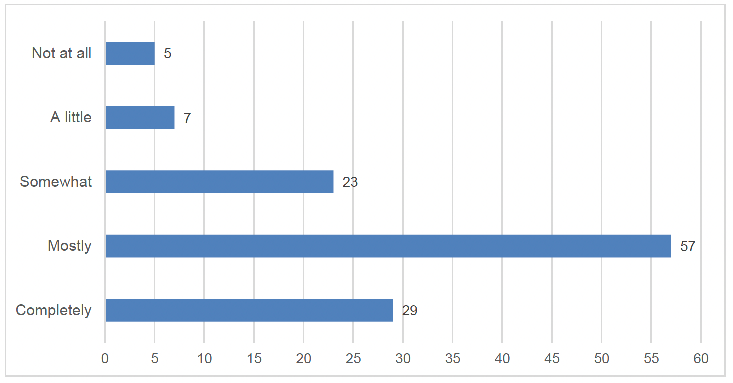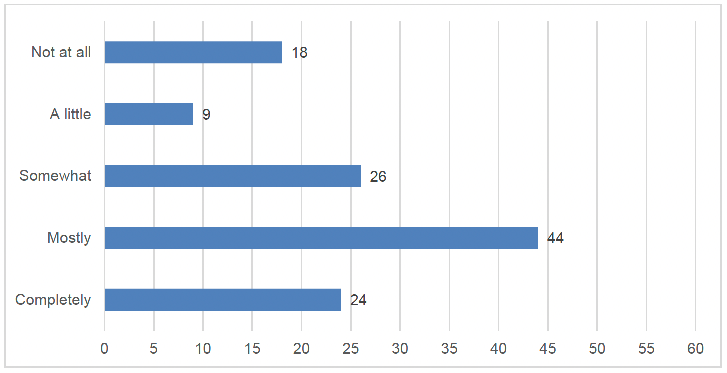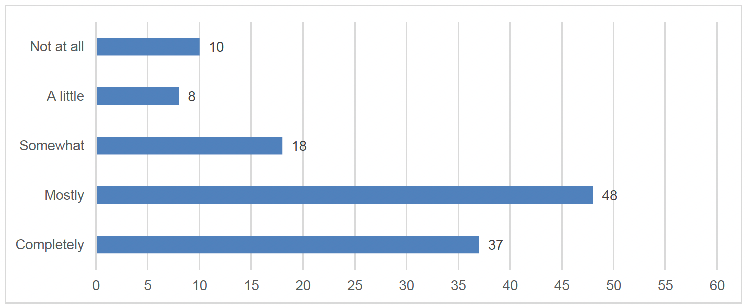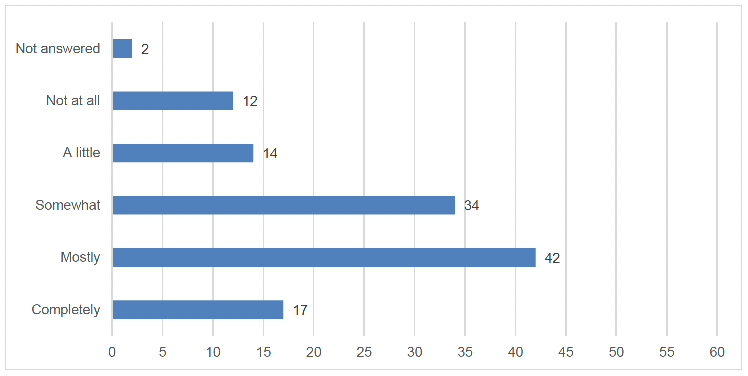Getting it right for every child – wellbeing assessment 2022: statutory guidance - consultation analysis
Analysis of responses received to the consultation on the Getting it right for every child – statutory guidance - assessment of wellbeing 2022 – Part 18 (section 96) of the Children and Young People (Scotland) Act 2014.
2. Assessment of Wellbeing
The statutory guidance on wellbeing is intended for practitioners and service leads in services that work with children and families and is in line with Section 96 (3) of The Children and Young Persons (Scotland) Act 2014 (The Act). The guidance aims to clarify how the eight wellbeing indicators are used to assess the wellbeing of children and young people and will explain what wellbeing is in the context of The Act.
This report provides an overview of the findings from the public consultation on the Assessment of Wellbeing. Each question is addressed in turn. The first four questions are purely quantitative and the fifth and sixth questions are qualitative.
Question 1: How clear and easy is the guidance to understand?
Responses to Question 1 are set out in Figure 2 below.

As Figure 2 above shows, 47% of respondents indicated that the guidance was mostly clear and easy to understand, 24% indicated it was completely clear and easy to understand, 19% indicated that it was somewhat clear and easy to understand and 6% indicated that it was a little clear and easy to understand. 4% indicated that it was not at all clear and easy to understand.
Question 2: With regard to the assessment of wellbeing, within the overall GIRFEC approach, does the guidance make practitioners' roles and responsibilities clear?
Responses to Question 2 are set out in Figure 3 below.

Responses to this question were mixed. 20% of respondents indicated that the guidance completely makes practitioners' roles and responsibilities clear, 36% indicated mostly and 21% indicated that it was somewhat clear. 15% of respondents indicated that it was not at all clear, and 7% of respondents felt that it was only a little clear.
Question 3: Are the definitions provided for the wellbeing indicators (section 6.1) clear and easy to understand?
Responses to Question 3 are set out in Figure 4 below.

As Figure 4 above indicates, the majority of respondents were positive with 39% indicating that the wellbeing indicators were mostly clear and easy to understand and 31% indicating that the indicators were completely clear and easy to understand. A further 15% found them somewhat clear and easy to understand, 7% indicated that they were only a little clear and easy to understand and 8% not at all clear or easy to understand.
Questions 4: To what extent do you think that the guidance will help practitioners understand how to embed the United Nations Convention on the Rights of the Child, and to protect, respect and uphold children's rights within the assessment of wellbeing?
Responses to Question 4 are set out in Figure 5 below.

35% of respondents indicated that they thought the guidance would mostly help practitioners to understand how to embed the the United Nations Convention on the Rights of the Child, and to protect, respect and uphold children's rights within the assessment of wellbeing. 14% indicated it would completely help practitioners, 29% felt that it would somewhat do so and a further 12% thought that it would do so a little. 10% did not think that it would do so at all.
Question 5: Can you outline anything specific that would be helpful to add to this guidance to assist the assessment of wellbeing?
and
Question 6: Are there any areas where the further development of resources or guidance would be helpful in supporting the assessment of wellbeing?
The responses to these two questions have been combined as they generated the same themes and to deal with each individually would be repetitious.
Positive comments
Overall, most respondents were very positive about the ways in which the voice of the child was encouraged and threaded throughout the guidance. Many respondents said that the refreshed guidance reflects and acknowleges the complexities which surround children's wellbeing on a daily basis and sets out a good framework for supporting and nurturing the young person.
"Real strengths around respecting and promoting children's rights and the positive impact this has on a child's wellbeing." (Local Authority)
"Communication is vital and this is reinforced throughout the document." (Local Authority)
"Welcome the explicit recognition that wellbeing is not finite or a fully quantifiable element, but influenced by a range of factors and levels, including physical and psychological health." (Local Authority)
Respondents made a range of suggestions for amendments and additions to the guidance on the assessment of wellbeing. The suggested changes are outlined in the sections below.
Responsibility for the wellbeing assessment
Some respondents said that it was vital that the guidance was clear about who is ultimately responsible for conducting and leading the assessments of wellbeing.
"The guidance needs to be clear about whose responsibility it is to do the assessments, explain who 'staff' are and what the time frame will be of this assessment." (Individual)
Some other respondents noted concern that if the assessment of wellbeing falls predominantly on school staff, they may have challenges finding the time to undertake the assessment when they are already over-stretched and under-resourced.
"Doing wellbeing analyses and creating child plans are incredibly time consuming and there has been no additional provision provided to schools for this: no extra staff, no new leadership roles, no additional funding. Head Teachers and teachers already have far too much to do and hardly any non-contact or available time to do most aspects of their job let alone adding more to the GIRFEC process." (Individual)
Accessibility of the document
Some respondents suggested that the addition of images to the guidance may be helpful, especially for practitioners working in communities where English is not the first language spoken. Respondents also suggested that an audio version of the guidance would be beneficial for any practitioners with visual impairments.
Some respondents suggested that a child-friendly version of the wellbeing assessment, and a user-friendly version for all children and young people, including those with additional learning needs, would be a helpful additional resource. Some suggestions provided by respondents to the consultation included using tools such as Talking Mats and My World Triangle in the assessment of children with communication or other challenges in their lives which they felt would help children understand what wellbeing means to them.
"Children must be recognised and related to as rights-bearing individuals who are partners in their own care, including children and young people with disabilities. The guidance could go further to outline barriers to participation for children and young people and how these barriers can be prevented." (National Body)
One respondent suggested that the guidance would greatly benefit from the addition of strategies for meaningful engagement with children or young people which enable them to take a leading role, should they wish to, in their own assessment and follow-on treatment or care. For example, if a child or young person is not able or does not wish to use their voice for self-expression it is not appropriate to be offered an assessment that requires them to talk.
"Adequate provision of non-talking therapies such as arts therapies (art, drama, dance-movement and music) is key to achieving such engagement through this form of creative-expressive, projective and/or psychotherapeutic, person-centred interaction. The arts therapies promote choice and full systemic participation, so the child or young person is understood and empowered within their social and educational context." (National Body)
Gender Inequality
Many participants from the consultation events with children and young people struggled with the concept of gender inequality and suggested that the addition of a glossary to explain complex words like gender inequality would help them understand the guidance more clearly.
Some respondents felt that the guidance document made no direct reference to gender inequality and that a clear statement needed to be included in the guidance in relation to understanding and identifying multiple and overlapping gender inequalities where both girls and boys are negatively impacted by the harmful effects of gender inequality and gender-based stereotypes.
Furthermore, it was suggested that the guidance document would be strengthened by including guidance on the importance of recognising the multi-dimensional impacts of inequalities on wellbeing.
"It is fundamental that practitioners working with children understand gender inequality, how it presents, the impact it has on all children and how to use that understanding within the wellbeing assessments of individual children and groups of children." (Voluntary)
"Inequalities have direct and indirect impacts on the wellbeing of children and young people. These impacts vary depending on the individual's protected characteristics which can create additional vulnerabilities. In addition, they vary depending on how such protected characteristics relate to and overlap with wider societal inequalities and on any further protective or exacerbating factors. These may include but are not limited to, nutrition, confidence, ability to express emotions, engage in learning environments, and have healthy friendships or relationships." (Voluntary)
Definitions of wellbeing
Many respondents said that the guidance needs to better clarify the definition of wellbeing.
"The only guidance as to its meaning is provided is where it lists eight factors to which regard is to be had when assessing wellbeing. The factors, which are known under the acronym SHANARRI, are that the child or young person is or would be: "safe, healthy, achieving, nurtured, active, respected, responsible, and included". These factors are not themselves defined, and in some cases, are notably vague." (Individual)
Many participants in the consultation events with children and young people struggled with the definition of wellbeing and needed extensive explanations to fully grasp this concept. Participants highlighted the need for a glossary to explain complex words like wellbeing.
"Why don't they just say happy, healthy and safe as that would be easier to understand."
"Wellbeing is a word with lots of meanings, please make it simpler!"
Some respondents also suggested that the guidance would greatly benefit from the addition of a definition around what is meant by health and wellbeing.
"Health is a state of complete physical, mental and social wellbeing and not merely the absence of disease or infirmity." (National Body).
A few respondents suggested including some illustrations such as the wellbeing wheel or GIRFEC National Practice Model, which would further support practitioners' understanding.
Many respondents felt that the concepts underpinning the SHANARRI indicators are complex and could be elaborated on further in the guidance to ensure practitioners have a consistent understanding of what is meant by each.
"For example, 'nurtured' is explained as having a 'nurturing' place to live. The meaning of this is open to interpretation, and further detail about what is meant by nurtured/nurturing (for example, loving, warm, caring) would be of benefit. Furthermore, the emphasis within the 'nurture' indicator is on the home environment; in line with the principles and intentions of GIRFEC it is imperative that the importance of nurture in other settings such as school, community, clubs etc. is cited." (Voluntary)
Some respondents also said that the guidance provides a limited exploration and explanation of the level of child or parental involvement in wellbeing assessments and decision-making.
"Does partnership mean that children and families will be considered 'partners' in decision making, or only 'included' in the process of decision making?" (Voluntary)
Furthermore, a few respondents raised concerns that the guidance does not sufficiently clarify or recognise the role of the third sector in wellbeing assessments.
"There is a need to recognise the third sector as equal partners, and it needs to be better accounted for in this guidance. If we are to #KeepThePromise, how does this guidance apply to the third sector in delivering early intervention, where they may increasingly actually be the lead professional? If GIRFEC is to span the entire spectrum of need and risk for children and young people, it will need to consider services that are delivered by non-statutory partners." (Voluntary)
Information sharing
A few respondents raised concerns about the limited clarity within the practice guidance materials about information sharing.
"Where the guidance states that service providers in the community may have information relevant to children's wellbeing, which may be important to inform a wellbeing assessment; but this leaves several practical questions open to interpretation. Is it a duty/responsibility for the lead professional/named person to seek this information? Is it a duty/responsibility for the service provider to convey this information? Where does this fit with data protection/confidentiality?" (Voluntary)
"When practitioners' assessment is that there are wellbeing concerns about a child, practitioners require clarity about how and when to share information with others and need to work together with children and families to support and enhance wellbeing under a preventative and rights-respecting approach. The statutory guidance does not offer any additional clarity on information sharing, which is especially important given the range of multi-agency partners from different disciplines who need a shared understanding of what is required." (Multi – Agency)
Timing of assessments
A few respondents raised concern over the lack of detail concerning when a wellbeing assessment should be undertaken and the relevant triggers for such assessments and felt that as a result there is a risk that assessments will focus primarily on the most severe and clearest cut cases related to welfare issues rather than wellbeing issues. They concluded that while the broad principles of the Act appear clear, the guidance does little to encourage or enable practitioners to combat anything but the severest cases of infringement.
"This leaves plenty of room for marginal but significant harms to young people in Scotland." (Voluntary)
Children with Disabilities
A few respondents raised concerns about the wellbeing assessment being used with children and young people affected by mental disability, observing that the "best interests" principle creates challenges for children and young people in the context of the United Nations Convention on the Rights of Persons with Disabilities. In particular, they wished to see the exercise of individual discretion in decisions related to "best interests" being reduced to ensure appropriate representation of children's interests and ensure that decisions are informed by a disability perspective.
"The principle is not precisely determined: there are no tightly defined criteria for determining how the principle should be implemented in general and concerning children and young people with disabilities. Children and young people with disabilities experience barriers to exercising their rights in addition to those barriers which impact children and young people in general. Disabled children and young people can experience overprotection due to adults' beliefs that, due to impairments, they do not have sufficient mental capacity to make safe or wise decisions. Exercise of individual discretion in 'best interests' decisions must therefore be reduced by providing for review, and accountability, based on agreed standards and guided by the principles of UNCRC." (National Body)
Support and training
Some respondents expressed concern about the lack of guidance around the training that will be given to those conducting the assessment of wellbeing, especially for those in the third sector.
"Not all organisations particularly within the third sector have access to the same training as those within the NHS and need to rely on their own capacity and staff skills mix, often drawn from staff who previously worked for the NHS, which can prove challenging in staying up to date with changes to GIRFEC. To strengthen the guidance, consideration of how access to current training can be improved in non-NHS service providers, to ensure the best outcomes for the children and young people they are supporting needs." (Health)
Furthermore, the guidance states that skills, knowledge and understanding will be developed and maintained through professional learning. In response to this, one respondent queried how teachers will be supported to do this and how they will gain these skills, knowledge and understanding.
Many respondents said that further resources need to be added to the guidance to support practitioners in the analysis and assessment of the information they gather to ensure that sound judgements and decisions are made to keep children safe and promote their welfare.
Collaboration
Many respondents said that it would be useful for the importance of partnership working to be added to the guidance document to improve the quality and timing of interventions and access to referral services for each child between health, education and social work agencies. A few respondents also suggested that national events need to be held to allow for the sharing and development of practice.
"The Edinburgh Children's Services Partnership has the GIRFEC principles well embedded and could share learning and lend support to other councils and partnerships less familiar with the national practice model." (Local authority)
"Clear guides in the nationally available practice materials will be essential; sharing good practice across Scotland at national meetings/events /forums People need tools to use as well as guidance about what to use for children at different developmental stages." (Health)
Court cases
A few respondents reported concerns around the wellbeing of a child while they await an outcome if a wellbeing case reaches a court situation and wished to see the guidance document cover this scenario.
"Even when an allegation is found to be unfounded, misplaced or opportunistic the potential nurturing relationship may have been damaged beyond repair. The Guidance should heed Lady Hale's words in the UK Supreme Court: "No child should be brought up to believe that she has been abused if in fact she has not, any more than any child should be persuaded by the adult world that she has not been abused when in fact she has." (National Body)
Contact
Email: girfec@gov.scot
There is a problem
Thanks for your feedback